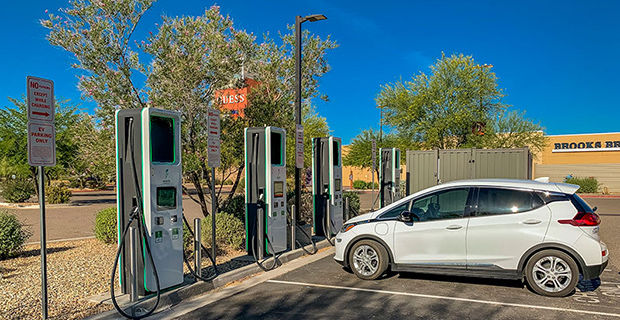AZ may receive $76.5M for EV charging access

Arizona is on track to receive $76.5 million from the federal government to improve accessibility to electric vehicle charging stations. This is thanks to the National Electric Vehicle Infrastructure Formula Plan.
The plan was implemented after bi-partisan support of the Infrastructure Investment and Jobs Act.
Local environmental advocates like Arizona PIRG Education Fund, Southwest Energy Efficiency Project and Western Resource Advocates are praising the new plan and are pushing for speedy action to implement it. The Arizona Department of Transportation must submit a statewide plan in order to receive the funding.
Since electric vehicles are a relatively new concept, there are still nationwide disparities in accessibility to charging stations. While electric vehicles are great for everyday commuting, many people are hesitant to take them on long distance trips because of concerns about being unable to recharge while on the road.
Diane Brown is the executive director of Arizona PIRG Education Fund, an organization that advocates for public health, safety and wellbeing. According to her, ADOT plans to install corridors with charging stations every 50 miles. She says that the plan will help alleviate the current gaps along roadways and reduce range anxiety.
According to ADOT, the bipartisan Infrastructure Bill will make $5 billion dollars available to states over the next five years. This money will go toward implementing publicly accessible electric vehicle charging stations along alternative fuel corridors. By implementing more EV charging stations, the plan is expected to encourage more people to switch over to electric vehicles, a cleaner alternative to fossil fuels.
According to the United States Environmental Protection Agency, EVs have a smaller environmental footprint than gasoline cars. This is because EVs have no tailpipe emissions, so they produce significantly less greenhouse gases.
Aaron Kressig, the transportation electrification manager of Western Resource Advocates, said electric vehicle use is a step in the right direction to reach net zero carbon emissions. Western Resource Advocates is an organization that focuses on protecting the climate, air, water and land of seven Western states. Scientists say reaching net zero emissions by 2050 is crucial to reducing the effects of climate change.
Kressig said climate change has led to hotter, drier weather in the American West. This creates a “feedback loop” where the dry conditions lead to more wildfires. The wildfires then emit more greenhouse gases. As a result, the Southwest has seen a surge in wildfires, resulting in mass destruction of homes and wildlife habitats.
Fossil fuel emissions can also negatively impact human health. The emissions can lead to heart attacks, respiratory disease, stroke and asthma, according to Harvard T.H. Chan School of Public Health. So, it is hoped that more people switching to electric vehicles will reduce these conditions.
“Air quality and public health benefits continue to escalate the more drivers switch to cleaner vehicles,” Brown said.
Public transportation and school buses in Arizona are also beginning to consider switching to electric buses, she said. Environment Arizona, an environmental advocacy organization, says if all the nation’s diesel-powered buses were replaced with electric, it could eliminate up to 2 million tons of greenhouse gas emissions per year.
Phoenix school districts are beginning to make the switch to electric buses. Not only are schools seeing the financial benefit, but students with respiratory conditions like asthma are seeing health improvements.
Over time, electric vehicles are less expensive to operate. According to the Electrical Safety Foundation International, this is because users do not have to pay for gas or oil changes. In a time of high gasoline prices, electric vehicle owners are saving big.
The plan also recommended utility companies incentivize EV owners with reduced costs for charging during off-peak hours. This is due to cheaper energy costs during late night and early morning hours, when less energy is being used.
EPA also says that fossil fuels burned by cars can contribute to higher levels of acid rain and smog. According to Kressig of Western Resource Advocates, the American West is particularly vulnerable to smog and ozone pollution. Because metro areas like Phoenix and Los Angeles are in valleys, the ozone tends to sink into the valley and affects the air quality for those living in the cities.
While electric vehicles are less expensive to operate over time, buyers may be intimidated by the upfront cost. Charging stations are also less likely to be built in low-income areas. This is because they are more expensive in areas where they get less use.
However, Kressig said that advocacy groups like Western Resource Advocates are advocating for EV access in low-income areas. He encouraged those buying vehicles to consider used EVs. As time goes on, older and used electric vehicles are becoming more affordable.
“With all the exciting stuff that’s happening already at the utility and state level, this support from the federal government can’t be underestimated in terms of what it’s going to do to accelerate the transition to EVs, which, with absolute certainty, is critical to meeting our climate targets,” Kressig said.
